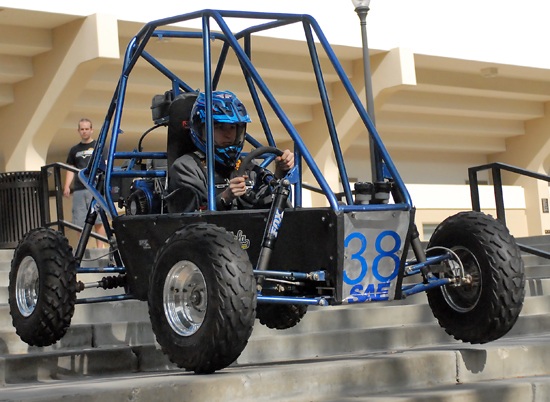Bruins design and build a race car from scratch for the Baja Society of Automotive Engineers competition

UCLA Baja SAE project leader and fourth-year mechanical engineering student Mike Rauls drives a car used in last year’s competition. The engineering students on the team designed and built the car for the competition, placing 31st out of 100 other universities.
By Jillian Ames
April 19, 2010 10:20 p.m.
On May 19, the UCLA Baja Society of Automotive Engineers’ dedication in building a race car from scratch will finally pay off as they head to the race track to compete in the annual Baja SAE race.
Baja SAE is a regional competition in which engineering students from 100 different schools build a car and race it around a terrain track that is one or two miles in length. The track is designed to challenge the expertise of the cars’ builds, as it contains jumps, obstacles and lots of mud that could easily destroy a poorly constructed vehicle. Participants are given a standard 10-horsepower motor and expected to design and build a race car.
“Working on a vehicle is something that doesn’t get taught in class,” said Mike Rauls, the UCLA Baja SAE project lead. “Manufacturing enhances an individual’s understanding of the design process.”
Last year the team’s members did not do as well as they had hoped, placing 31st overall. The car snapped a chain within the first 30 minutes of the four-hour endurance race, causing the team to make quick adjustments on the spot, said Lucas Meza, the project’s drive train lead.
This year, the car is designed using a modified chassis frame and suspension system to make it more durable. A lower center of gravity will also help to sturdy the car.
“This year we are hoping to place in the top 10,” said John Nguyen, the brakes lead of the project.
“We have been continually improving over the years, but it’s difficult to compete with schools that have been participating for 20 or 30 years while UCLA has only been competing for 11,” Meza said.
Rauls added that some schools even hold tryouts to be accepted onto the team, which often discourages the involvement of less-experienced students. These students could benefit from seeing advanced concepts applied before getting to them in classes.
In contrast, UCLA does not hold tryouts for the Baja race, presenting all students with an opportunity to gain hands-on experience.
According to Rauls, the car is first designed using a computer-aided drafting program called SolidWorks. This enables students to calculate exact geometric measurements of individual car parts, which they build completely from scratch using tubing and billet aluminum.
“A majority of our materials are donated by sponsors,” Meza said. “All of our aluminum this year was donated by Kaiser Aluminum, and other sponsors like Polaris and Briggs sell us (parts) at discounted prices.”
Although it may not seem beneficial from an economic standpoint for companies to donate free parts and materials to the team, Rauls explained that in the long run, companies indirectly profit from the donations, as students enter the job market more experienced and require less training. The companies also gain future customers and name recognition.
The car is welded free of charge by Dukes Welding and Fabrication. The owner of the company feels a strong affiliation with UCLA, as he was born in one of the medical centers, Rauls said.
“Most people who come in here are engineers, but don’t necessarily know anything about cars,” Rauls said.
Although winning is a goal of the UCLA Baja team, the practical experience gained is much more valuable than finishing No. 1 on May 19, Rauls said.


